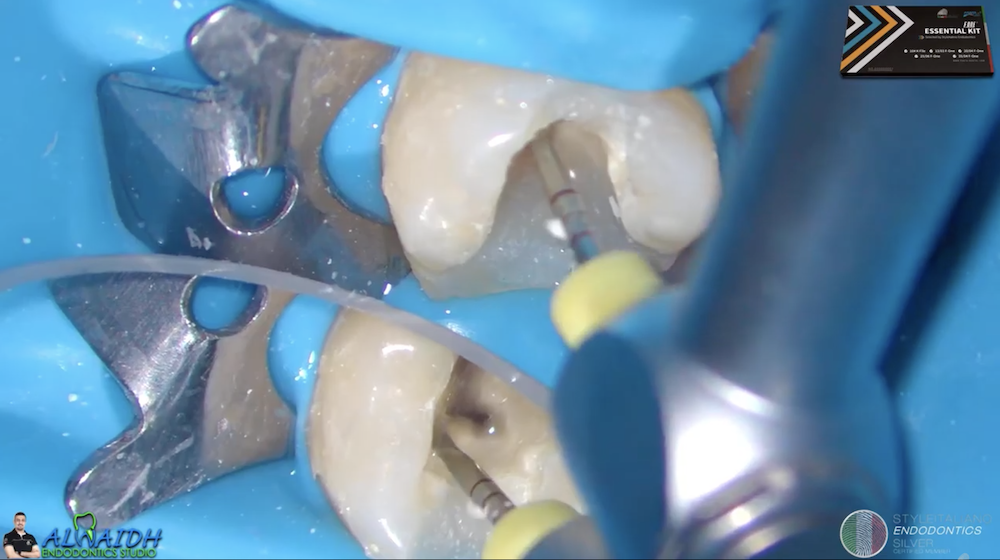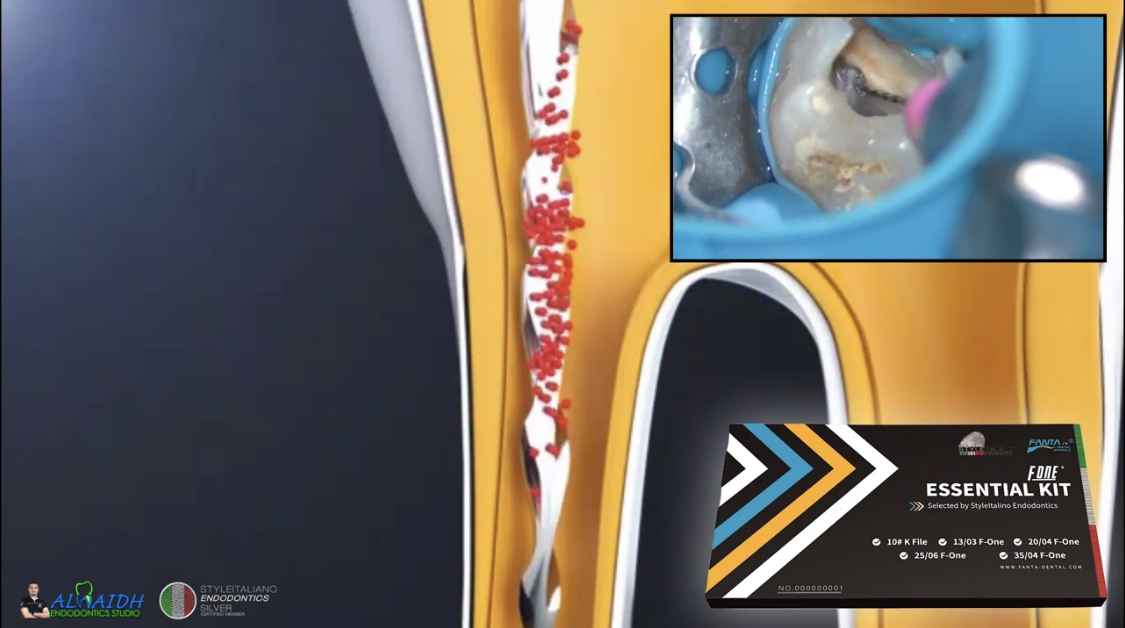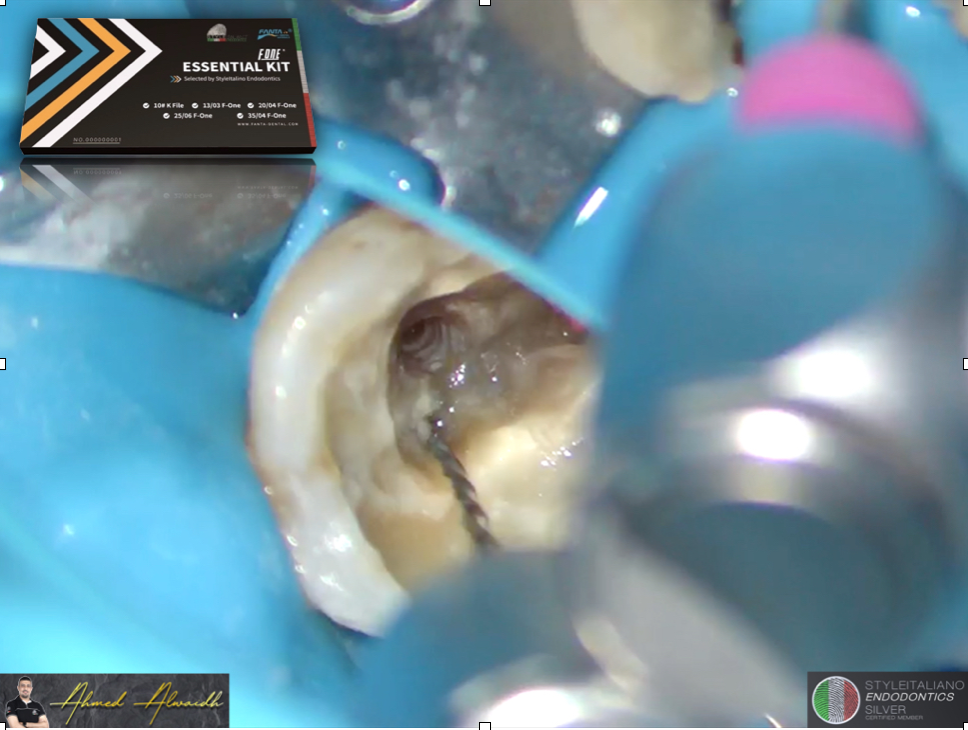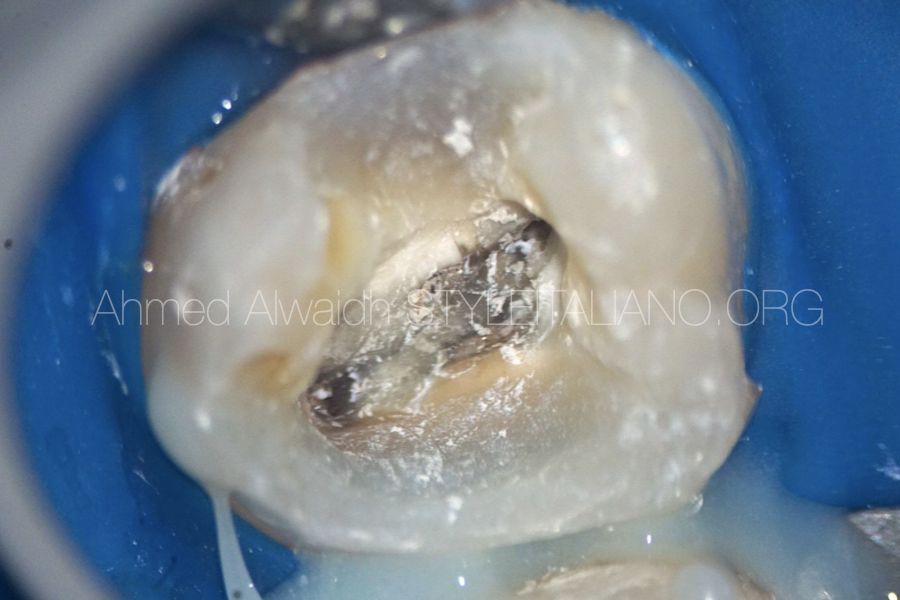
Mechanical scouting with Glider ST
13/01/2022
Ahmed Alwaidh
Warning: Undefined variable $post in /var/www/vhosts/styleitaliano-endodontics.org/endodontics.styleitaliano.org/wp-content/plugins/oxygen/component-framework/components/classes/code-block.class.php(133) : eval()'d code on line 2
Warning: Attempt to read property "ID" on null in /var/www/vhosts/styleitaliano-endodontics.org/endodontics.styleitaliano.org/wp-content/plugins/oxygen/component-framework/components/classes/code-block.class.php(133) : eval()'d code on line 2
Canal negotiation sometimes can be very difficult or challenging, especially with narrow, secondary, or calcified canals. In this case of a maxillary molar, pulp chamber and canals were extremely calcified.
A 35 years old female patient been referred to restore her upper right teeth. Pt complains of discomfort when food get trapped between her upper right molars, with mild sensitivity to cold drinks and food. History of her upper molar fracture 6 months ago when she was eating olive. Patient reported that she avoids eating on the right side to prevent discomfort.
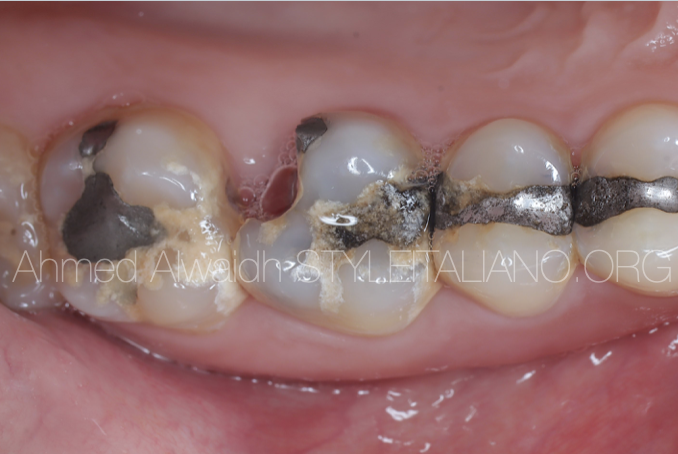
Fig. 1
Clinically, many calculus was evident on the upper posterior teeth. UR6 (upper right first molar) was with deep distal decay. Severe lingering response to cold test and no tenderness to percussion.
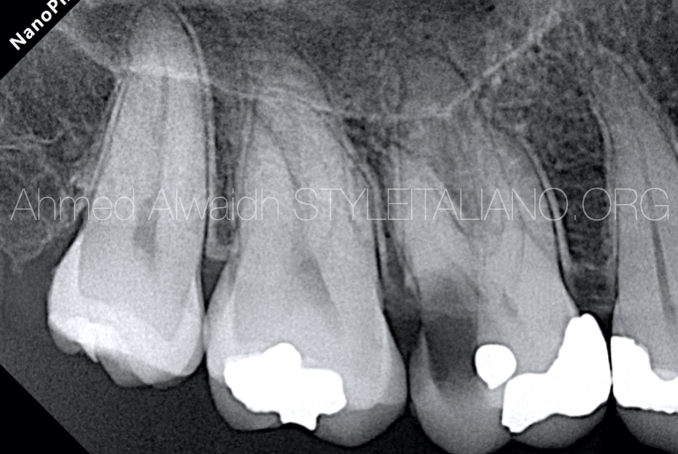
Fig. 2
IOPA (intra-oral peri-apical) radiograph revealed very deep distal cavity in UR6, with evident calcified pulp chamber, and normal peri-apical tissue.

Fig. 3
Bite-wing radiograph to assess the restorability of the tooth.
Diagnosis: UR6 with AIP (asymptomatic irreversible pulpitis) with normal apical tissue.
Treatment plan:
After discussing with the patient about the pros and cons of treatment options and the destructive distal decay, and also discussing with referral dentist about the need for local crown lengthening then full coverage crown, it has been decided to go for the NSRCT (non-surgical root canal treatment) for UR6.
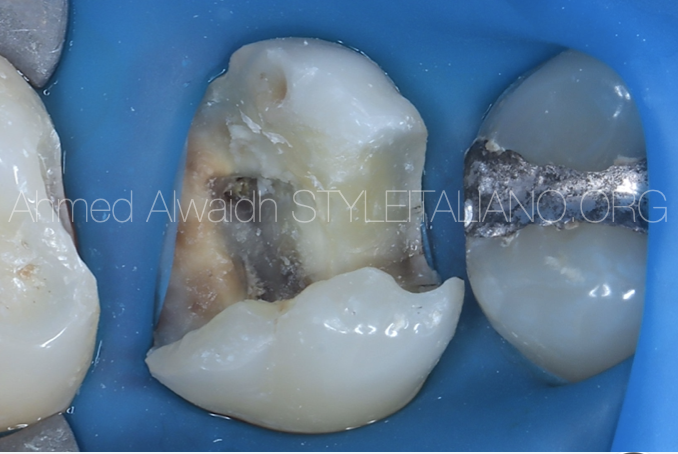
Fig. 4
After removing the calculus and rubber dam been placed, old restoration and decay been removed.
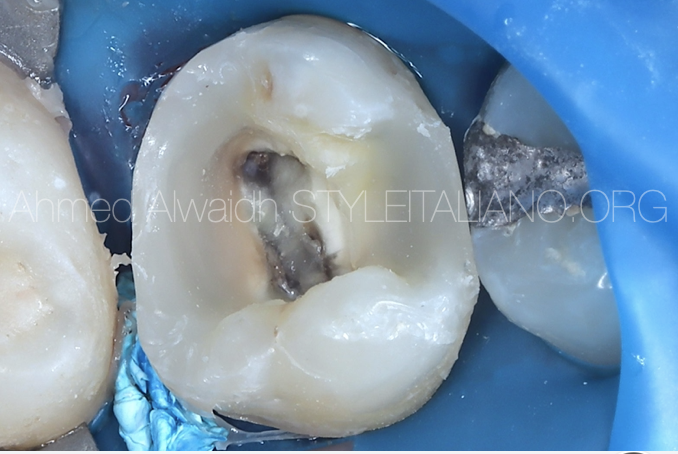
Fig. 5
UR6 been converted into CL1 cavity with resin composite restoration.
Pulp chamber of UR6 was vey calcified. Ultrasonic tip been used to refine the pulp map and orifices of the canals.
After manual negotiation and finishing preparation of MB1, DB, and P canals with F One #25/04, I was unable to negotiate MB2 with hand files, even with C file #06!
With the use of Glider ST (F One #13/03, one of the F One Essential kit selection by Style Italiano Endodontics), it was easily to mechanically scout the coronal third of the very narrow and calcified MB2.
F One #25/04 then was used to enlarge and pre-flare the coronal third of MB2 canal.
After pre-flaring the coronal third of MB2, hand files again were not able to scout the canal! So Glider ST (#13/03) was used again, and it mechanically scouted smoothly the MB2 canal up to full working length.
F One #25/04 then was used to prepare the canal after mechanically scouted with Glider ST (#13/03).
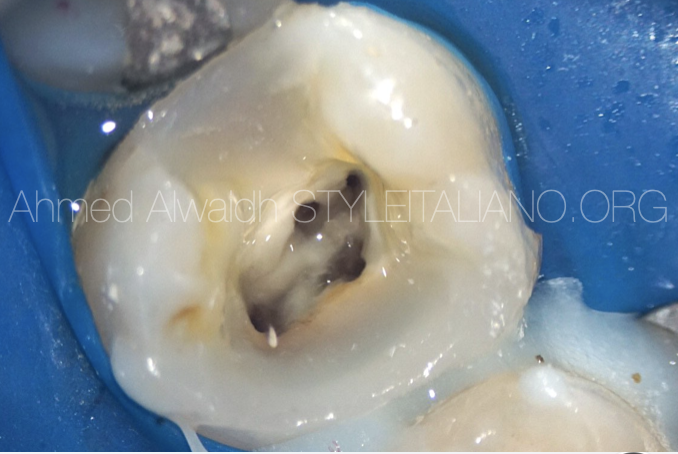
Fig. 6
After preparing all of the 4 canals of UR6 with F One #25/04, thorough irrigation with NaOCl 3%, EDTA 17%, and activated by ultrasonic (PUI). The canals are ready for obturation.
MB2 was merging with MB1 at the apical third.
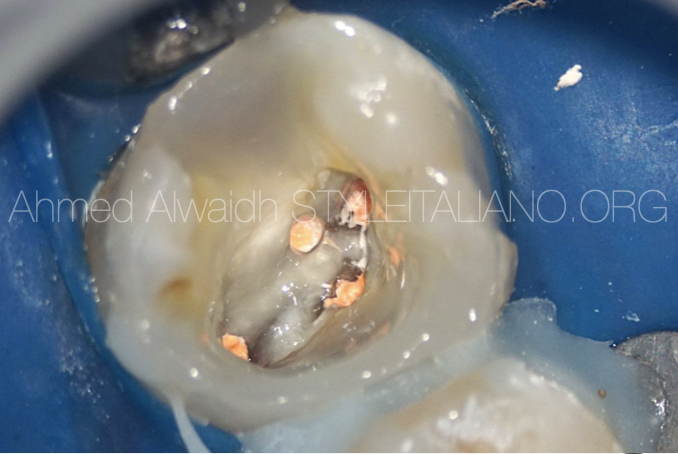
Fig. 7
Canals were obturated by hydraulic obturation with Bioceramic cement.
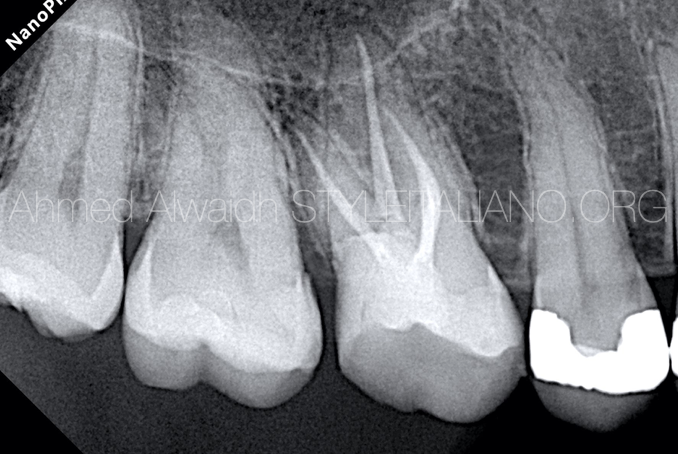
Fig. 8
Immediate final IOPA showing a complete NSRCT of UR6
Conclusions
Calcified canals sometimes represent a real challenge and may preclude proper Endodontic treatment, and for this reason, such cases require a good experienced practitioner, professional tools, and sometimes modification in the treatment protocol to ensure proper chemo-mechanical preparation. Many articles and clinical cases (1-15) been published showing the benefits and uses of the flat side design of the F One file (Fanta Dental, Shanghai, China).
In this case, the MB2 canal was extremely calcified that it was impossible to negotiate with hand files. But with the use of the Glider ST (F One #13/03) that was selected carefully by a joint cooperation between members of Style Italiano Endodontics and Fanta Dental, and been designed to deal with such difficult cases.
Bibliography
1- Di Nardo D, Miccoli G, Mazzoni A, Seracchiani M, Gambarini G, Testarelli L (2020) Centering ability of a new nickel-titanium rotary instruments with a peculiar flat-side design: an in vitro study. J Contemp Dent Pract 21(5), 539-42.
2- Gambarini G, Miccoli G, Seracchiani M, et al. (2019) Role of the flat-designed surface in improving the cyclic fatigue. resistance of endodontic NiTi rotary instruments. Materials 12(16), 2523.
3- A Multi-Disciplinary Approach in Non-Surgical Re-treatment of Mandibular Right First Molar, Ahmed Alwaidh.
4- Conservative treatment of an upper molar, Alexandru Gliga.
https://endodontics.styleitaliano.org/conservative-treatment-of-an-upper-molar/
5- Essential kit: how to use it in practice, Massimo Giovarruscio.
https://endodontics.styleitaliano.org/essential-kit-how-to-use-it-in-practice/
6- Fanta F-One Essential Kit in action, Alexandru Gliga.
https://endodontics.styleitaliano.org/fanta-f-one-essential-kit-in-action/
7- Management of a three rooted premolar with Fanta Essential Kit, Riccardo Tonini.
8- Manualless shaping "IT IS POSSIBLE”!, Mohamad Zaafrany.
https://endodontics.styleitaliano.org/manualless-shaping-it-is-possible/
9- MB2: The Most Famous Missed Canal, Mohamad Zaafrany.
https://endodontics.styleitaliano.org/mb2-the-most-famous-missed-canal/
10- Mechanical bypass of separated instruments, Ahmed Alwaidh.
https://endodontics.styleitaliano.org/mechanical-bypass-of-separated-instruments/
11- Modification in canal preparation for long and narrow canals of lower first molar, Ahmed Alwaidh.
12- Shaping Essentials and Furcal Canal Case Report, Mohamad Zaafrany.
https://endodontics.styleitaliano.org/shaping-essentials-and-furcal-canal-case-report/


